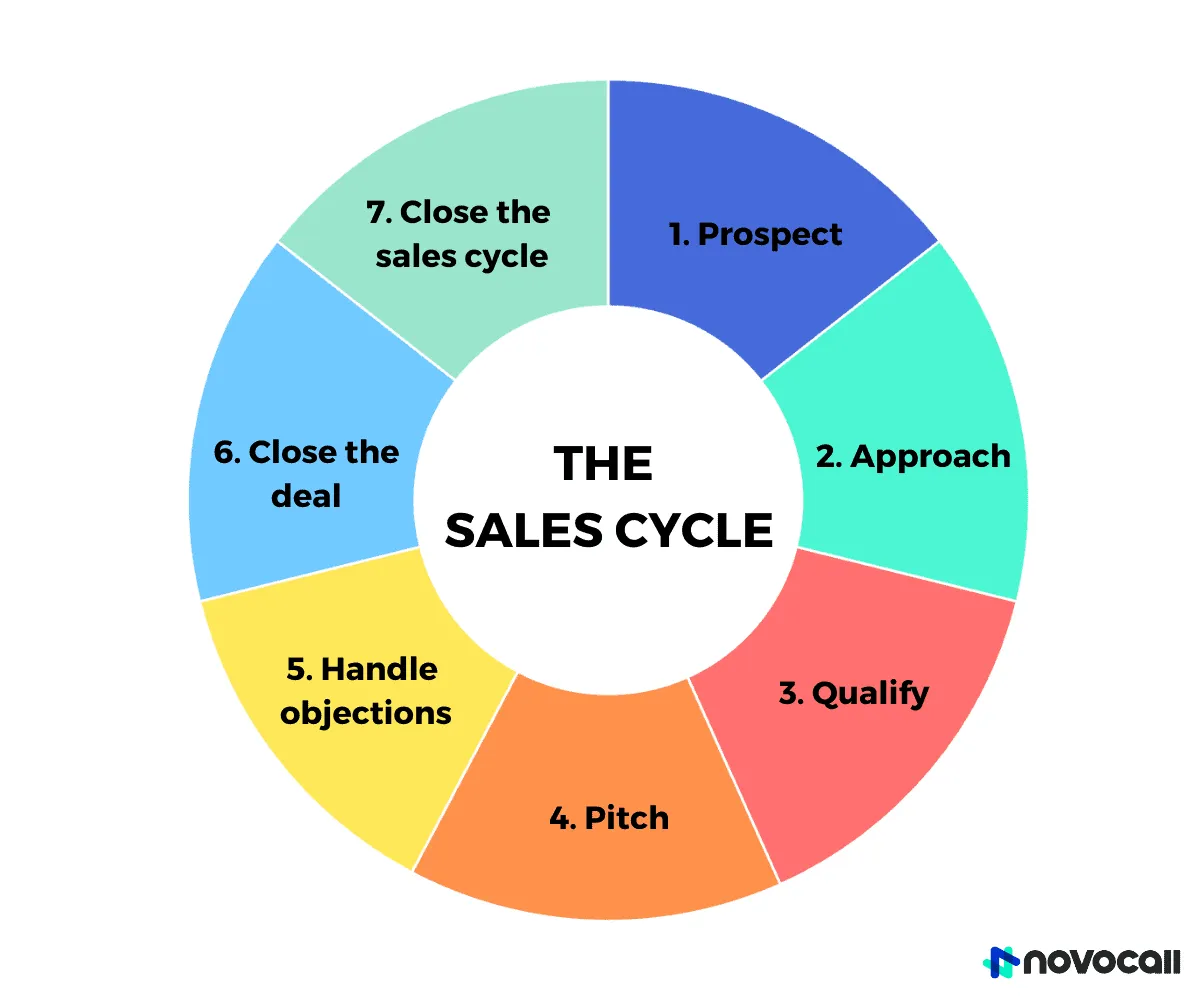

Start driving better conversations.
Novocall will be your new favorite business phone system.

Businesses have different ways of closing deals depending on the industry and product that they’re selling.
Some follow a structured process, while others try different strategies and see what sticks.
But, studies have shown that companies with a proper sales process in place generate 18% more revenue than those who don’t.
That’s because these companies have a clearly defined structure to fall back on that paves the way for future actions. Sales teams aren’t left guessing what to do next.
And this structure is called the sales cycle.
In this article, we help you understand what a sales cycle is and why it’s important.
A structured sales cycle gives businesses insight into the efficiency of sales operations.
By identifying and analyzing the different stages of the sales cycle at a granular level, you get insights into what you’ve done well and what didn’t work.
What stages did you move through quickly? Which methods have you tried and tested? Where are you lacking?
You can use your understanding of the sales process to optimize those actions that lead up to a successful deal or make for a smoother sales process.
The sales cycle refers to a defined process that companies follow when trying to close a deal, from generating leads to follow-ups. Businesses undergo different stages of the sales cycle depending on their industry and product or service.
So why exactly is the sales cycle so important?
Generally, the sales cycle consists of 7 main stages. However, it’s important to note that this does not apply to every business.
A B2B sales cycle is much longer and might consist of different stages as compared to a B2C sales cycle.

Let’s dive deeper into each stage of the sales cycle! 👇

Prospecting is what kicks off the sales cycle. Without leads, your salespeople will have no one to sell to.
Businesses have to first come up with an ideal customer profile (ICP). Remember, every business transaction should be mutually beneficial.
Your customers provide monetary value to you, your product or service should address their business needs.
To identify the ideal customer, you need to ask yourself questions to see if there is a good match. Some of the questions look like these:
This helps your salespeople identify quality leads because you know where to look and who you’re looking for. At the same time, it makes sure that you are what the potential customer is looking for.

Now that you’ve got all your leads ready, it’s time to initiate contact.
It’s important that you do some research here, such as finding out their potential challenges and how your business will be able to help them.
This helps you angle your messaging to target them better and find common ground to connect with them.
There are several ways you can approach your leads – cold calls, cold emails, or social media. Many businesses use a combination of these methods, so there isn’t a perfect formula or method that can guarantee success.
But, you could try mirroring their tonality or leverage on case studies to increase your chances of getting them interested in your product or service.

In a perfect world, every lead you approach will turn into paying customers. Unfortunately, that isn’t the case. 😢
That’s why businesses have to qualify leads before pushing them further down the sales funnel. You can even use software to help you with this.

For example, Novocall’s click-to-call software is integrated with Facebook lead ads. This allows users to cast a wider net to reach out to a wider audience and set qualification questions that will pop up when someone clicks on your Facebook lead ad.
This step is a great opportunity to really see if the list of leads you created in the first step is truly aligned with the research and prospecting you’ve done. In an interview with the Chief of Sales Insights at Serve Don’t Sell, Litson Witherill, you should pay attention to 4 factors:
Again, it all boils down to a great product/service-customer fit.
This helps your sales reps narrow down the pool of leads to the prospects with the highest buying potential who have a much higher chance of purchasing from you eventually.
Do note that if a lead isn’t a good fit now, don’t cast them aside and forget about them forever. Send their contact information to the marketing team so they can keep them in their email campaigns.
Who knows, maybe in a few months, they’ll see the value of your product. 😉

So you’ve gathered your leads, contacted and qualified them, what’s next?
It’s time to start selling both your company and product or service.
There are a few ways you can do this, but we’ll be focusing on two methods:
(1) Conducting email nurturing before pitching with cold calls
(2) Starting directly with cold calls
If you start with an email nurturing sequence, you need to be very aware of which stage of the marketing funnel each lead is in.
You should have an email sequence of content prepared for every stage and push them down the funnel until they are ready to schedule a demo with you where you can conduct your pitch. The help of AI copywriting tools can come in handy here, as they can help you to create highly relevant and personalized content for each stage of the funnel.
Your pitch should be relevant and personalized. Highlight the specific problem your prospect is facing and how exactly your product solves that problem. After all, your aim here is to try to convince them why your product makes sense.
Also, you should highlight the benefits your product can bring instead of solely focusing on listing the features. Your prospects are probably more interested in what they can get out of your product, rather than how awesome it is 😎
💡 Read more: 14 cold calling tips to convince customers to buy

It’s common that there will be prospects who aren’t completely convinced about how your product can help them.
“It’s too expensive”…🥺
“Competitor X has this feature, why don’t you have it?”…🤔
“We need these features that you don’t have”…🥱
You’ll most likely be bombarded with many questions about why your product isn’t good enough or that it’s too expensive.
But don’t be discouraged.
Take this opportunity to convey your value proposition and highlight the benefits of using your product.
Just remember that success takes time. Rome wasn’t built in a day.

After the questions have been addressed and your prospect is now onboard, it’s time to dish out that contract and negotiate the terms.
Avoid giving them discounts if the prospect suddenly backs out, as this can actually decrease the odds of successfully closing the sale by 17%.
Remember to be patient and empathize with their concerns. No one likes being rushed or pressured into buying something.
Instead, go for a softer approach and emphasize how your product can help address their pain points. Send them case studies again to show that they could be achieving those results if they use your product.
Once they’ve signed (you can also use an eSign tool to speed up the process) and have officially become a paying customer, don’t just stop there. Get your customer success team to follow up and guide them through the onboarding process, and make sure that they know how to use your product or service.
Don’t make them regret their purchase decision!

You did it! You made the sale.
Thank them for their support and assure them that you will provide them with the best customer support possible.
Sometimes, things just don’t work out and you get rejected.
In this instance, ask them if they would like to receive content casually from your team. For free.
Perhaps they still need more convincing that your company and product or service is the one for them. This is where email sequences come in.
They provide contacts with content about your company, industry, and product in a bid to convince them that you are the best company to solve their business problems.
Asking for referrals can help your reps kick start the sales cycle all over again. In fact, 84% of B2B decision-makers start the buying process with a referral.
However, there is no ‘best time’ to ask for referrals.
Some see success when they’ve asked a customer right after their purchase. Some wait till their customers have started using the product. Some ask after months.
One thing to note is that customers will most likely give you referrals when they’re in a good mood. So ask them when you know they’re satisfied with your product or service.
We hope that this article has given you a better understanding of what a sales cycle is and why it’s important.
If you don’t have a structured process in place, you should get started now. You could be one of those companies getting more revenue than your competitors! 😛
That said, if you’ve noticed by now, a typical sales cycle can be pretty long. But fret not! We got you covered. Check out our guide on shortening your sales cycle today!
💡 For more resources to help you in your sales journey, subscribe to our blog below!

Faye is a digital marketing executive at Novocall. When she’s not busy writing articles for Novocall’s blog, she spends her time baking and playing with her dogs.
Discover more
Subscribe to our blog
Get insights & actionable advice read by thousands of professionals every week.

